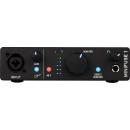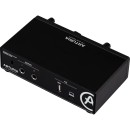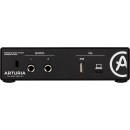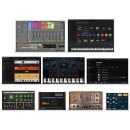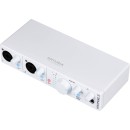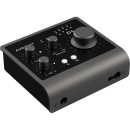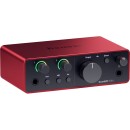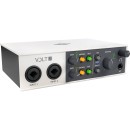Arturia MiniFuse 1 Portable 1x2 USB Type-C Audio Interface: Comprehensive Review
- 1x2 USB Type-C audio interface
- 24-bit/192kHz resolution
- Single XLR-1/4" combo input
- 48V phantom power for condenser mics
- Direct monitoring with mix control
- Stereo RCA line outputs
- Headphone output with level control
- MIDI input/output
- Bus-powered
- Rugged, portable design
- Includes software package with virtual instruments and effects
Arturia MiniFuse 1 Specifications, Advantages, and Disadvantages
The Arturia MiniFuse 1 is a portable 1x2 USB Type-C audio interface designed for musicians, podcasters, and content creators seeking high-quality sound in a compact form. This versatile interface features a single XLR/TRS combo input that supports both microphone and line-level signals, making it ideal for recording vocals, instruments, or other audio sources. With a 110 dB dynamic range and a low-noise preamp, the MiniFuse 1 ensures crystal-clear audio capture, allowing users to achieve professional-grade recordings with ease.
Equipped with a USB Type-C connection, the MiniFuse 1 offers fast and reliable data transfer, ensuring minimal latency and seamless integration with modern computers and devices. The interface also includes two balanced 1/4" TRS outputs for connecting to studio monitors or other playback systems, as well as a headphone output with dedicated volume control for precise monitoring. Additionally, the MiniFuse 1 is bus-powered, eliminating the need for an external power supply and enhancing its portability for on-the-go recording sessions.
The Arturia MiniFuse 1 also comes with a comprehensive software bundle, including Ableton Live Lite, Analog Lab Intro, and a variety of virtual instruments and effects, providing users with a complete production toolkit right out of the box. Its rugged yet lightweight design ensures durability while maintaining portability, making it an excellent choice for creators who need a reliable and versatile audio interface.
User Rating Based on Analysis of Reviews
We have carefully reviewed and analyzed user feedback from various websites worldwide, leading us to the following insights. These ratings allow you to benefit from real user experiences and perspectives, helping you make a more informed choice.
Purchase Value
85% of users were satisfied with the purchase value of the Arturia MiniFuse 1, highlighting its affordability and the impressive range of features offered for the price. Many users found it to be a great investment for both beginners and seasoned musicians looking for a portable, reliable interface without breaking the bank.
15% of users felt that the purchase value did not meet their expectations, primarily due to perceived competition offering similar features at a slightly lower price or with additional bundled software, which made them question the overall value proposition.
Sound Quality
90% of users were pleased with the sound quality, appreciating the clarity and warmth of audio recordings. The preamps were frequently praised for their low-noise performance and the overall fidelity, making it a top choice for audio professionals seeking quality results.
10% of users expressed dissatisfaction with sound quality, citing occasional issues with noise or interference in specific recording environments. A few users also mentioned that while the quality was good, it did not surpass their existing equipment.
Build Quality
80% of users were satisfied with the build quality, indicating that the Arturia MiniFuse 1 felt solid and well-constructed. The materials used were noted for their durability, making it suitable for regular transport and use.
20% of users were dissatisfied with the build quality, mentioning concerns about the plastic components feeling less robust than metal alternatives. Some users reported issues with the durability of the USB ports after extended use.
Portability
95% of users praised the portability of the MiniFuse 1, pointing out its compact size and lightweight design which make it ideal for mobile recording setups. Many users highlighted its ease of setup and transportation as major advantages.
5% of users were not completely satisfied with the portability, often due to personal preferences for even smaller devices or because they needed additional connectivity options that required carrying extra equipment.
Ease of Use
88% of users found the MiniFuse 1 extremely easy to use, with straightforward plug-and-play functionality and intuitive controls that made setup and operation simple, even for those new to audio interfaces.
12% of users encountered challenges with ease of use, particularly those who struggled with driver installations or compatibility issues with specific operating systems, which detracted from the otherwise user-friendly experience.
Software Compatibility
83% of users were satisfied with the software compatibility, noting seamless integration with popular DAWs and minimal driver issues. Many appreciated the bundled software, which expanded the interface's capabilities.
17% of users faced issues with software compatibility, primarily due to difficulties in integrating with less common DAWs or encountering glitches with bundled software that required troubleshooting.
Customer Support
70% of users who needed customer support were satisfied with the assistance they received. They appreciated the knowledgeable and responsive service that helped resolve their issues efficiently.
30% of users were dissatisfied with customer support, reporting delays in response times and occasional difficulty in obtaining solutions for technical problems, leading to frustration.
Latency
92% of users were impressed by the low latency of the MiniFuse 1, which provided real-time monitoring and minimal delay, crucial for professional recording and live performance settings.
8% of users experienced latency issues, particularly in complex recording setups or when using specific software configurations, which impacted their recording experience negatively.
Connectivity Options
78% of users appreciated the connectivity options available, such as the USB Type-C interface, which provided reliable and fast connections compatible with modern devices.
22% of users were dissatisfied with the limited connectivity options, wishing for additional inputs and outputs to accommodate more complex recording needs or additional instruments.
Design
86% of users enjoyed the design of the MiniFuse 1, noting its sleek, modern appearance and the intuitive layout of its controls, which added to its aesthetic appeal and functionality.
14% of users criticized the design, finding it too minimalistic for their taste or expressing a preference for more robust visual indicators and controls for easier use in low-light settings.
Driver Stability
84% of users found the drivers for the MiniFuse 1 to be stable, reporting few issues with crashes or interruptions during use, which contributed to a reliable recording experience.
16% of users faced instability with drivers, particularly those using older operating systems or with specific hardware combinations, leading to occasional disruptions in their workflow.
Bundled Software
82% of users appreciated the bundled software, noting that it added value and expanded the creative possibilities right out of the box, with many finding it a great starting point for music production.
18% of users were disappointed with the bundled software, either due to limited licenses or because they preferred software that was not included, reducing the perceived added value.
Durability
77% of users were satisfied with the durability of the MiniFuse 1, indicating that it held up well under regular use and transport, which is essential for mobile recording artists.
23% of users had concerns about durability, pointing to specific parts like the knobs or jacks that showed wear with frequent use, which could impact long-term reliability.
Output Quality
89% of users were pleased with the output quality of the MiniFuse 1, reporting clear and accurate sound reproduction that met their expectations for professional audio work.
11% of users were dissatisfied with output quality, often due to specific setups where they experienced unexpected noise or output discrepancies, which required additional troubleshooting.
Preamp Quality
91% of users rated the preamp quality highly, praising the clear and powerful amplification with minimal noise, essential for capturing high-quality recordings.
9% of users found the preamp quality lacking, mainly when pushing the gain to higher levels where they experienced distortion or noise, which affected their recording quality.
Aesthetic Appeal
87% of users valued the aesthetic appeal of the MiniFuse 1, finding its design modern and attractive, which complemented their studio setups visually.
13% of users were not satisfied with the aesthetic appeal, often because they preferred a more traditional or rugged look that matched their existing equipment.
Versatility
80% of users found the MiniFuse 1 versatile, capable of handling a variety of recording scenarios from home studios to live performances, making it a flexible tool for different needs.
20% of users felt the interface lacked versatility, particularly those needing more advanced routing options or additional input/output capabilities for more complex setups.
Power Supply
75% of users were satisfied with the power supply options, appreciating the convenience of USB power which eliminated the need for additional adapters and made mobile use straightforward.
25% of users were dissatisfied with the power supply, mainly due to concerns about relying solely on USB power which, in some cases, limited use with certain devices or configurations.
User Manual
73% of users found the user manual helpful, providing clear instructions and guidance for setup and troubleshooting, which was beneficial for new users.
27% of users were dissatisfied with the user manual, citing a lack of depth in explanations or insufficient detail for complex troubleshooting, which left them seeking additional support.
Overall Satisfaction
88% of users expressed overall satisfaction with the Arturia MiniFuse 1, noting it as a reliable and high-quality interface that met their recording needs and offered excellent value for money.
12% of users were not fully satisfied, often due to specific issues that affected their experience, such as software compatibility or connectivity limitations, which they found restrictive for their projects.
In this section, we will delve into the detailed specifications of the Arturia MiniFuse 1 Portable 1x2 USB Type-C Audio Interface. Our comprehensive review will cover every aspect of this product, and we will also provide a balanced analysis of its advantages and disadvantages. Continue reading to find out if the MiniFuse 1 meets your audio production requirements.
Pros:
- Affordable price point for entry-level users.
- Compact and portable design, easy to carry.
- USB Type-C connectivity ensures fast data transfer and compatibility with modern devices.
- High-quality preamps provide clear sound quality.
- Comes with a software bundle including Ableton Live Lite and other useful tools.
Cons:
- Limited to a single input, which may not be sufficient for more complex recording needs.
- No MIDI input/output, limiting connectivity to MIDI devices.
- Plastic build may not be as durable as metal alternatives.
- Lacks advanced features found in higher-end audio interfaces.
General
| Channels of I/O | Analog: 1 Input / 2 Outputs |
|---|---|
| Maximum Sampling Rate | 192 kHz / 24-Bit |
| Number of Microphone Inputs | 1 Preamp |
| Input Level Adjustment | 1x Knob |
| Expansion Slots |
The Arturia MiniFuse 1 Portable 1x2 USB Type-C Audio Interface is designed to provide a streamlined and efficient way to connect audio equipment for recording and playback. Show More
Channels of I/O: This specification indicates the number of audio channels available for input and output. With 1 input and 2 outputs, the MiniFuse 1 allows you to connect a single audio source, such as a microphone or instrument, while simultaneously sending the processed audio to two separate outputs. This is particularly useful for monitoring or sending audio to different devices.
Maximum Sampling Rate: The maximum sampling rate of 192 kHz at 24-bit signifies the audio quality you can achieve with this interface. A higher sampling rate allows for more accurate representation of sound frequencies, resulting in clearer and more detailed audio recordings. The 24-bit depth further enhances dynamic range, providing better quality especially in professional audio applications.
Number of Microphone Inputs: The MiniFuse 1 features one dedicated microphone preamp, enabling you to connect a microphone directly for recording vocals or instruments. The quality of the preamp can significantly affect the clarity and warmth of your recordings.
Input Level Adjustment: This feature includes a single knob for adjusting the input level. It allows you to easily control the gain of the audio signal coming into the interface, ensuring that recordings are neither too quiet nor distorted. Proper level adjustment is crucial for achieving optimal sound quality.
Expansion Slots: The absence of expansion slots in the MiniFuse 1 indicates that it is a compact and self-contained audio interface. While this may limit future expandability, it also simplifies the design and makes it ideal for users looking for a straightforward, portable solution without the need for additional hardware.
Signal Processing
| Pad | |
|---|---|
| Gain/Trim Range | Mic/Line/Hi-Z Inputs: 56 dB |
| High-Pass Filter | |
| Solo/Mute |
The Arturia MiniFuse 1 Portable 1x2 USB Type-C Audio Interface comes with a set of specifications that cater to various audio needs. Show More
The Pad feature indicates whether the interface includes a -20dB pad option to reduce the input level for very loud sound sources. In this case, the absence of a pad means that users will need to manage high audio levels without this attenuation, which could be crucial for preventing distortion during recordings of loud instruments or sound sources.
The Gain/Trim Range specifies the amount of amplification available for the inputs, and for the MiniFuse 1, it offers a range of 56 dB for Mic/Line/Hi-Z inputs. This wide range allows for flexibility in capturing various sound sources, from quiet vocals to louder instruments, ensuring that users can achieve a suitable recording level without noise or distortion.
The High-Pass Filter feature helps eliminate low-frequency noise, which is particularly useful for cleaning up recordings. However, the MiniFuse 1 does not include a high-pass filter, meaning users might need to apply this effect during post-production to manage unwanted low-end sounds.
Lastly, the Solo/Mute feature allows users to isolate or silence specific audio channels during monitoring. The absence of this feature on the MiniFuse 1 means that users will not be able to quickly toggle audio channels on and off while recording or mixing, which could limit workflow efficiency for some users.
Connectivity
| Analog Audio I/O | 1x Combo XLR-1/4" TRS Balanced/Unbalanced Mic/Line/Hi-Z Input (Front Panel) 2x 1/4" TRS Balanced Line Output 1x 1/4" TRS Unbalanced Headphone Output (Front Panel) |
|---|---|
| Phantom Power | 48 V, Selectable On/Off |
| Digital Audio I/O | |
| Host Connection | 1x USB-C |
| Host Connection Protocol | USB 2.0 |
| USB (Non-Host) | 1x USB-A (USB 2.0, Device Connection) |
| Sync I/O | |
| Network I/O | |
| MIDI I/O |
The Arturia MiniFuse 1 Portable 1x2 USB Type-C Audio Interface features a variety of audio input and output options designed to cater to different recording needs. Show More
Starting with the Analog Audio I/O, the interface includes a single combo XLR-1/4" TRS input on the front panel, which allows users to connect microphones, line-level devices, or high-impedance instruments directly. This versatility is crucial for musicians and audio engineers who may need to switch between different types of audio sources. Additionally, there are two 1/4" TRS balanced line outputs that ensure high-quality sound transmission, reducing noise and interference. For monitoring, a 1/4" TRS unbalanced headphone output is also provided, allowing users to listen to their recordings in real-time.
The Phantom Power feature is particularly important for those using condenser microphones, as it supplies the necessary 48 V power to operate these devices. The ability to toggle this feature on and off provides flexibility depending on the type of microphone being used.
In terms of Digital Audio I/O, the MiniFuse 1 does not support any digital input or output, which means that all audio connections are purely analog. This can be ideal for users who prefer a straightforward setup without the complexities of digital audio routing.
The Host Connection utilizes a single USB-C port, offering a modern connection standard that ensures compatibility with various devices and provides a reliable data transfer rate through the USB 2.0 protocol. Additionally, the interface includes a USB-A port that allows for device connections, expanding its functionality for other peripherals.
Finally, it is worth noting that the MiniFuse 1 does not feature Sync I/O, Network I/O, or MIDI I/O. This means that it is focused solely on audio input and output without the added complexity of syncing with other devices, networking capabilities, or MIDI control, making it a straightforward choice for users looking for a simple and effective audio interface. Overall, these specifications make the Arturia MiniFuse 1 a versatile tool for recording and monitoring audio in a portable format.
Performance
| Frequency Response | Mic Inputs: 20 Hz to 20 kHz ±0.06 dB (Min Gain) Hi-Z Inputs: 20 Hz to 20 kHz ±0.06 dB (Min Gain) Line Inputs: 20 Hz to 20 kHz ±0.05 dB (Min Gain) Line Outputs: 20 Hz to 20 kHz ±0.09 dB Headphone Outputs: 20 Hz to 20 kHz ±0.09 dB |
|---|---|
| Maximum Input Level | Mic Inputs: +9 dBu Hi-Z Inputs: +11.5 dBu Line Inputs: +22 dBu |
| Maximum Output Level | Line Outputs: +12 dBu Headphone Outputs: +11.4 dBu |
| Headphone Output Power | 137 mW into 33 Ohms |
| Impedance | Mic Inputs: 2.5 Kilohms Hi-Z Inputs: 1 Megohm Line Inputs: 16 Kilohms Line Outputs: 94 Ohms Headphone Outputs: 10 Ohms |
| Dynamic Range | Mic/Line/Hi-Z Inputs: 110 dB (A-Weighted) Line Outputs: 107.5 dB (A-Weighted) Headphone Outputs: 104 dB (A-Weighted) |
| THD+N | Mic Inputs: -100 dB (Unweighted, 1 kHz, Typical) Hi-Z Inputs: -91 dB (Unweighted, 1 kHz, Typical) Line Inputs: -100 dB (Unweighted, 1 kHz, Typical) Line Outputs: -101 dB (Unweighted, 1 kHz, Typical) |
| EIN | Mic Inputs: -129 dB A-Weighted |
The specifications provided for the Arturia MiniFuse 1 Portable 1x2 USB Type-C Audio Interface highlight key performance metrics critical for audio quality and functionality.Show More
Frequency Response indicates the range of frequencies the audio interface can effectively reproduce. The MiniFuse 1 boasts a frequency response from 20 Hz to 20 kHz for various input and output types, which covers the full audible spectrum for human hearing. This ensures that both low and high frequencies are captured accurately, resulting in a balanced and natural sound quality across microphones, instruments, and line-level sources.
Maximum Input Level defines the highest signal level the interface can accommodate without distortion. With inputs for microphones, Hi-Z instruments, and line signals at different levels (+9 dBu, +11.5 dBu, +22 dBu respectively), this specification is crucial for preventing clipping and ensuring clear audio capture, especially when working with dynamic sources that can produce high levels.
Maximum Output Level specifies the peak levels that the outputs can produce before distortion occurs. The MiniFuse 1's line and headphone outputs are rated at +12 dBu and +11.4 dBu respectively, providing sufficient headroom to drive speakers and headphones effectively without compromising audio integrity.
Headphone Output Power measures the power delivered to connected headphones, which is important for achieving a suitable listening level. With an output of 137 mW into 33 Ohms, users can expect robust audio playback, allowing for a detailed listening experience when monitoring recordings or mixes.
Impedance affects how the interface interacts with connected devices. The MiniFuse 1 has varying impedances for its inputs and outputs, such as 2.5 Kilohms for mic inputs and 10 Ohms for headphone outputs. Lower impedance values generally help in achieving better signal transfer, making the interface compatible with a wide range of audio equipment.
Dynamic Range is a measure of the difference between the smallest and largest signal levels the device can handle. With a dynamic range of 110 dB for inputs and 107.5 dB for outputs, the MiniFuse 1 can capture and reproduce sounds with great detail, ensuring the quietest sounds are heard while preventing distortion on louder signals.
THD+N (Total Harmonic Distortion plus Noise) quantifies the distortion introduced by the interface. The MiniFuse 1 boasts impressive figures, with mic and line inputs showing -100 dB, indicating that the device minimally alters the original audio signal, preserving fidelity.
EIN (Equivalent Input Noise) reflects the inherent noise level of the microphone inputs. The MiniFuse 1 has an EIN of -129 dB A-Weighted, signifying a very low amount of noise, which is essential for professional audio work where clarity is paramount. This allows for clean recordings, particularly of quiet sources.
Overall, these specifications showcase the Arturia MiniFuse 1 as a capable and versatile audio interface, suitable for both amateur and professional audio applications.
Digital Audio
| Sample Rates | 44.1 / 48 / 88.2 / 96 / 176.4 / 192 kHz |
|---|---|
| Sample Rate Conversion | |
| Bit Depths | 24-Bit |
| Latency | Zero-Latency Direct Monitoring |
| Sync Sources | Internal |
The Arturia MiniFuse 1 Portable audio interface features several key specifications that enhance its functionality and performance. Show More
Sample Rates indicate the number of samples of audio carried per second and are crucial for determining the quality of sound reproduction. The MiniFuse 1 supports a wide range of sample rates, including 44.1 kHz up to 192 kHz, allowing for high-definition audio recording and playback. This flexibility ensures that users can select the appropriate sample rate for various applications, from music production to podcasting, offering pristine audio quality.
Sample Rate Conversion refers to the ability of the device to convert audio from one sample rate to another. In the case of the MiniFuse 1, it does not feature sample rate conversion. This means that users need to ensure the sample rate of their audio sources matches the selected rate on the interface for optimal performance.
Bit Depths represent the number of bits used to encode the audio signal, influencing the dynamic range and noise floor of the recording. The MiniFuse 1 utilizes a 24-bit depth, which allows for a greater dynamic range and higher audio fidelity compared to lower bit depths. This is particularly beneficial for capturing the nuances of sound in professional recordings.
Latency is the time delay between input and output, which can impact the recording experience. The MiniFuse 1 features Zero-Latency Direct Monitoring, allowing users to hear their input signal in real-time without any noticeable delay. This is essential for musicians and vocalists who need to perform and monitor their sound without distraction.
Sync Sources refer to the methods used to synchronize multiple audio devices. The MiniFuse 1 has an Internal sync source, meaning it generates its own clock signal to manage timing for audio playback and recording. This is standard for most audio interfaces and ensures reliable performance during recording sessions.
Together, these specifications make the Arturia MiniFuse 1 a versatile and high-quality audio interface suitable for various audio applications, providing users with excellent sound quality and performance.
Audio Storage & Playback
| Memory Card Slot |
|---|
The Arturia MiniFuse 1 Portable 1x2 USB Type-C Audio Interface does not come with a memory card slot. This feature is significant as it indicates that the device relies on external storage solutions for recording and playback, typically through a connected computer or other digital audio workstation (DAW). The absence of a memory card slot means users will need to utilize their computer's storage capabilities to manage audio files, which can be beneficial for those who prefer a streamlined setup without the need for additional hardware.Show More
In the context of audio interfaces, a memory card slot can offer convenience for recording on-the-go or in situations where a computer may not be readily available. However, for many users, especially those working in a studio environment or using a laptop, the reliance on a computer can simplify the workflow. The MiniFuse 1 focuses on portability and ease of use, making it a suitable choice for musicians and content creators who prioritize connectivity and performance without the added complexity of managing multiple storage mediums.
Compatibility
| OS Compatibility | macOS Windows |
|---|---|
| Required Hardware | Available USB 2.0 Port USB Cable (Included) |
| Internet Connection | Required for Registration, Software/Driver Download |
The Arturia MiniFuse 1 Portable 1x2 USB Type-C Audio Interface offers compatibility with both macOS and Windows operating systems, making it versatile for users of different platforms. This feature ensures that musicians and audio professionals can integrate the MiniFuse 1 into their existing setups regardless of their computer's operating system, enhancing its usability in diverse environments.Show More
In terms of required hardware, the MiniFuse 1 necessitates an available USB 2.0 port, which is standard on most computers. This is crucial as it allows for easy connection without the need for additional adapters or complex setups. The inclusion of a USB cable in the package further simplifies the setup process, enabling users to start making music right out of the box.
Additionally, an internet connection is required for registration and the download of necessary software and drivers. This is typical for modern audio interfaces, ensuring that users have access to the latest updates and features. It allows for a seamless setup experience and ensures the device operates with optimal performance by utilizing up-to-date drivers. Overall, these specifications contribute to the MiniFuse 1’s functionality and user-friendliness, making it an excellent choice for portable audio recording.
Power
| Power Requirements | USB Bus Power |
|---|
The Arturia MiniFuse 1 Portable 1x2 USB Type-C Audio Interface operates using USB Bus Power. This means that it draws power directly from the computer or device it is connected to via a USB cable, eliminating the need for an external power supply. This feature is particularly beneficial for users who require portability, as it allows for easy setup and use in various locations without the hassle of additional power cords.Show More
The reliance on USB Bus Power also contributes to a streamlined design, making the MiniFuse 1 lightweight and compact—ideal for musicians and audio professionals on the go. It can be connected to laptops, tablets, or other USB-compatible devices, ensuring that users can maintain a clean and organized workspace. Overall, this specification enhances the interface's versatility and convenience, catering to both home studio setups and mobile recording scenarios.
Physical
| Anti-Theft Features | Kensington Security Slot |
|---|---|
| Dimensions | 5.9 x 3.9 x 1.6" / 15 x 9.9 x 4.1 cm |
| Weight | 0.9 lb / 0.4 kg |
The Arturia MiniFuse 1 Portable 1x2 USB Type-C Audio Interface comes equipped with several important specifications that enhance its usability and security for users. Show More
Anti-Theft Features: The inclusion of a Kensington Security Slot is a valuable feature for those who often work in public spaces or are concerned about the safety of their equipment. This slot allows users to attach a security cable, helping to deter theft and providing peace of mind when using the audio interface in various environments.
Dimensions: Measuring 5.9 x 3.9 x 1.6 inches (15 x 9.9 x 4.1 cm), the MiniFuse 1 is compact and portable. Its small size makes it easy to transport, fitting comfortably in a laptop bag or backpack. This is particularly beneficial for musicians, podcasters, or anyone in need of a mobile recording solution, as it can be used in a variety of settings without taking up much space.
Weight: Weighing just 0.9 lb (0.4 kg), the MiniFuse 1 is lightweight, enhancing its portability. This low weight allows users to carry it effortlessly, making it an ideal choice for those who need an audio interface that won't add significant bulk to their gear. Whether you’re traveling for a gig or setting up in a new location, the lightweight nature of the device contributes to a hassle-free experience.
Packaging Info
| Package Weight | 1.025 lb |
|---|---|
| Box Dimensions (LxWxH) | 6.9 x 5.3 x 1.9" |
The specifications for the Arturia MiniFuse 1 Portable 1x2 USB Type-C Audio Interface highlight key aspects that contribute to its usability, portability, and performance.Show More
Package Weight: The weight of the product is an important factor for users who need portability. At 1.025 lb, the MiniFuse 1 is lightweight, making it easy to carry for musicians, podcasters, or sound engineers who work on the go. A lighter interface means it can be easily packed in a bag or transported without adding significant bulk.
Box Dimensions (LxWxH): The dimensions of the box, measuring 6.9 x 5.3 x 1.9 inches, provide insight into the overall size of the product. These compact dimensions indicate that the MiniFuse 1 is designed for convenience and space-saving, making it ideal for use in small studio spaces or during travel. A smaller footprint ensures that it can easily fit alongside other equipment without taking up too much room.
Overall, these specifications demonstrate that the Arturia MiniFuse 1 is designed for users who prioritize portability and efficiency in their audio recording and production setups.
Customer Images
Videos
Customer Questions
How do I set up the Arturia MiniFuse 1 with my computer?
To set up the Arturia MiniFuse 1, first download and install the Arturia MiniFuse Control Center from Arturia's website. Connect the MiniFuse 1 to your computer using the included USB Type-C cable. Open the Control Center to configure your device and ensure it’s recognized by your computer.
Why is my Arturia MiniFuse 1 not being recognized by my computer?
Ensure that you have installed the latest drivers from Arturia's website. Check the USB connection and try a different USB port. Make sure the USB Type-C cable is securely connected. Restart your computer and reconnect the device.
How can I update the firmware on my Arturia MiniFuse 1?
Open the Arturia MiniFuse Control Center software. If a firmware update is available, you will be prompted to update. Follow the on-screen instructions to complete the firmware update process.
What should I do if there is no sound output from my Arturia MiniFuse 1?
Ensure that your headphones or speakers are properly connected to the MiniFuse 1. Check the volume levels on the device and within your DAW or audio settings. Verify that the correct output device is selected in your computer's audio settings.
How do I reduce latency when using the Arturia MiniFuse 1?
In your DAW, adjust the buffer size settings to a lower value to reduce latency. Make sure you are using the latest drivers from Arturia. Close any unnecessary applications that may be using system resources.
Can I use the Arturia MiniFuse 1 with a tablet or smartphone?
Yes, the Arturia MiniFuse 1 can be used with tablets and smartphones that support USB audio interfaces. You may need an appropriate USB adapter (e.g., USB Type-C to USB OTG) to connect the device to your tablet or smartphone.
Why is there a buzzing or humming noise in my recordings?
Check your cables and connections for any issues. Make sure you are using high-quality, shielded cables. Ensure that your recording environment is free from electrical interference. Grounding issues can also cause noise, so check your power sources.
How do I connect a microphone to the Arturia MiniFuse 1?
Plug your microphone into the XLR input on the front of the MiniFuse 1. If you are using a condenser microphone, make sure to enable phantom power (+48V) by pressing the corresponding button on the interface.
What sample rates does the Arturia MiniFuse 1 support?
The Arturia MiniFuse 1 supports sample rates up to 192 kHz. You can configure the sample rate settings in your DAW or through the Arturia MiniFuse Control Center.
How do I troubleshoot driver installation issues with the Arturia MiniFuse 1?
First, ensure that you have downloaded the correct driver for your operating system from Arturia's website. Run the installation file as an administrator. If you encounter issues, try disabling any antivirus software temporarily during installation. Restart your computer after the installation is complete.
Comparison
← SWIPE THE TABLE TO SEE MORE →
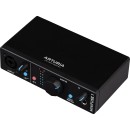
Arturia MiniFuse 1 |
VS | ||||
|---|---|---|---|---|---|
| Analog: 1 Input / 2 Outputs |
Channels of I/O |
Analog: 2 Inputs / 2 Outputs |
Analog: 2 Inputs / 2 Outputs at 96 kHz |
Analog: 2 Inputs / 2 Outputs at 192 kHz |
Analog: 2 Inputs / 2 Outputs |
| 192 kHz / 24-Bit | Maximum Sampling Rate | 192 kHz / 24-Bit | 96 kHz / 24-Bit | 192 kHz / 24-Bit | 192 kHz / 24-Bit |
| 1 Preamp | Number of Microphone Inputs | 2 Preamps | 1 Preamp | 1 | 2 Preamps |
| 1x Combo XLR-1/4" TRS Balanced/Unbalanced Mic/Line/Hi-Z Input (Front Panel) 2x 1/4" TRS Balanced Line Output 1x 1/4" TRS Unbalanced Headphone Output (Front Panel) |
Analog Audio I/O |
2x Combo XLR-1/4" TRS Balanced/Unbalanced Mic/Line/Hi-Z Input (Front Panel) 2x 1/4" TRS Balanced Line Output 1x 1/4" TRS Unbalanced Headphone Output (Front Panel) |
1x Combo XLR-1/4" TRS Balanced Mic/Line Input 1x 1/4" TRS Unbalanced Hi-Z Input (Front Panel) 2x 1/4" TRS Balanced Monitor Output 1x 1/4" TRS Unbalanced Headphone Output (Front Panel) 1x 1/8" / 3.5 mm TRS Unbalanced Headphone Output (Front Panel) |
1x XLR 3-Pin Balanced Mic Input 1x 1/4" TS Unbalanced Line/Hi-Z Input (Front Panel) 2x 1/4" TRS Balanced Monitor Output 1x 1/4" TRS Headphone Output (Front Panel) |
2x Combo XLR-1/4" TRS Balanced/Unbalanced Mic/Line/Hi-Z Input (Front Panel) 2x 1/4" TRS Balanced Monitor Output 1x 1/4" TRS Unbalanced Headphone Output (Front Panel) |
| 1x USB-C | Host Connection | 1x USB-C | 1x USB-C | 1x USB-C | 1x USB-C |
| macOS Windows |
OS Compatibility |
macOS Windows |
macOS 10.11.6 or Later macOS 11.1 or Later Windows 7 or Later 6 or Later iPadOS |
macOS Windows |
macOS 10.14 or Later Windows 10 (64-Bit Only) 14 or Later iPadOS 14 or Later |
| USB Bus Power | Power Requirements | USB Bus Power | USB Bus Power | USB Bus Power, USB Power Adapter (Not Included) | AC/DC Power Adapter (Not Included) or USB Bus Power |
